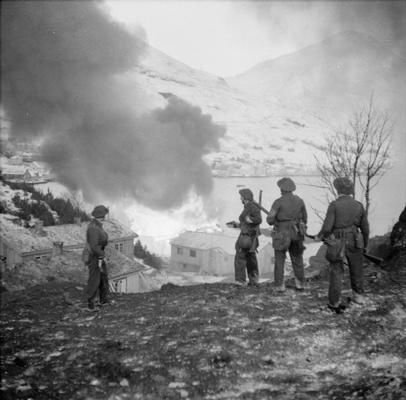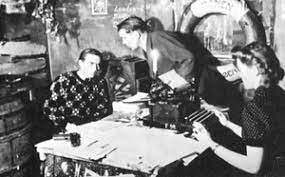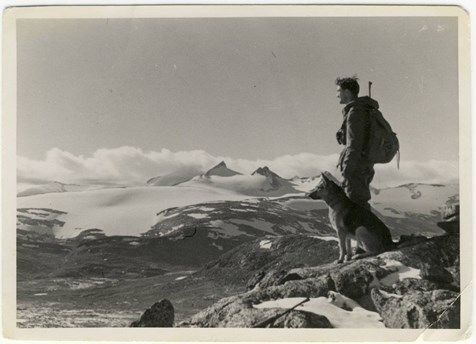Hannah Byron's Blog, page 13
December 12, 2021
1-Year Anniversary The Diamond Courier
On Friday 10 December I celebrated the 1st anniversary of the 2nd book in The Resistance Girl Series with a feeling of modesty and thankfulness. The Diamond Courier has sold around 2500 copies, had thousands of pagereads and paid back its investment in editing and cover costs.
2021 has so far been a good year for the 3 books that are now out in the series. Book 4 is on its way and 3 more are planned. I love writing about strong women in WW2 and am glad readers love my heroines.
So here’s to another year, Lili Hamilton! Enthrall your readers with your dangerous journey through the years of the war.

Here’s The Diamond Courier’s status this week. Order her here. Also in Kindle Unlimited.
Download The Diamond CourierDecember 4, 2021
The Norwegian Resistance Movement during WW2, Taking Form IV

Blog post III ended with the first uprising against the tightening grip of the German occupation authorities and the Norwegian fascists under the leadership of Vidkun Quisling and his Nasjonal Samling (NS) party.
Let’s look a global look at what happened in the fall and winter of 1940-1941 in the civil resistance.
Oslo as the hubMost of the struggle took place in Oslo - or at least was coordinated from the capital - as it was the seat of government and the center of all the important educational institutions and economic activities in Norway. Most of the national professional and trade organizations had their head offices in Oslo. So it was logical that the resistance movement also centered its attention there and continued to set up an organization in Oslo that could cater to the rest of the country.
The first teachers’ protestIn October 1940, the NS directed their demand for declarations of loyalty to public servants. Doctors and teachers were the first in the line of fire. Soon the trade unions, clergy and legal profession would follow. Those that refused to become party members were dismissed from their jobs on political grounds. It’s no wonder that these professional groups have continued to be at the heart of the resistance throughout the war.
The teachers’ organizations sent out a joint circular to their members, referring to their right to reject such pressure based on the Hague Convention. Despite the threat of dismissal, many refused to become an NS member and claimed teacher independence. The first nation-wide directive in the war (parole) was sent out in what has become known as the ‘Standfast’ struggle:

“With reference to the inquiry received, I hereby declare that I will remain true to my teaching vocation and my conscience, and that on that basis I shall, in the future as in the past, carry out the decisions relating to my work which are lawfully given by my superiors.”
The word ‘lawfully’ clarifies that the Norwegian public didn’t accept the NS as lawful. The sheer courage of this act of defiance would later resonate with even more power through the teacher ranks in 1942 when thousands were arrested and deported.
But for now, the wave of teacher protests and this first Standfast action resulted in the NS pressure taken off for the time being. It also enhanced solidarity among resisters and provided a pattern for other groups of public officials. The parole proved, both on this occasion and later, to be an effective instrument of warfare against nazification.
The legal governmentAnother powerful blow to the oppressing authorities was the resignation of the entire Supreme Court - the 3rd element in governing the country - in December 1940. They simply refused to set aside the principle of judicial independence, which the NS proclaimed. Now the Supreme court had taken side with the resistance, it legalized the ‘illicit’ opposition. Chief Justice Paal Berg and other Supreme Court judges went on to play a key role in Norway’s resistance movement.
The NS didn’t shun to show how it would undermine legal security. A ‘People’s Court was set up, which could deal with criminal cases at the request of the authorities. For example, the entire Labor Party group of the Oslo City Council was denounced and imprisoned after a protest. But many fore arrests happened without a trial. And the Hird - secret police, fashioned after Hitler’s SA - was let loose on the Norwegian streets to create havoc, without any intervention from the side of the police who were ordered to give them active support. It was a time of brute force and mob rule in Norway, with as its darkest moment the visit in January 1941 of the German Gestapo leader Himmler.
Breakdown of local self-governmentAlbert Viljam Hagelin was the second man of the NS and the only one to share Quisling’s fate of execution after the war. He was the ‘strong man’ of the party and headed the newly established Department for Home Affairs. On the day the Supreme Court ceased to function, an ordinance was sent out for changing local government law. The Fürherprincip (leader principle) was introduced into county and district administration. Representatives were no longer elected but nominated by his Department. This happened so suddenly that in this area, the NS was successful. Archives of a post-war inquiry show that in April 1944 82% of district chairpersons were NS members and that at the liberation of Norway everyone was a member or a fellow-traveler. On a local level, few of the old political leaders served as a sheet-anchor in the emergency. In sailors’ language, most of them were mere sea-anchors in the great political storms to which the German occupation had exposed the Norwegian community.
Church protestsAll the main divisions in the Norwegian Church came together in a Joint Christian Council under the leadership of the Bishop of Oslo, Eivind Berggrav, Professor Ole Hallesby and the lay preacher Ludvig Hope. They sent out an Episcopal letter that also quickly found its way to the government-in-exile in London. Their point was firm and clear:
“When those in authority in the community tolerate violence and injustice and oppress the souls of men, then the Church is the guardian of men’s consciences… On that account the bishops of the Church have laid before the Minister some of the facts and official announcements concerning the administration of the community…which the church finds to be in conflict with the law of God…”
The NS tried to counter the bishops by police actions in and outside the churches and Bishop Berggrav was summoned to meet Reichskommissar Terboven and Himmler to answer for his doings.

As with the legal professions, the suppression only led to the clergy taking the side of the resistance and play an important role in it during the rest of the war. Some of them, like Ludvig Hope ended up in concentration camps
Trade unionsThe forces of resistance in the trade union organisation (LO) and Labor movement were feebler, certainly during the winter of 1940/41. The reason was partly because Germany had a pact with the Soviet Union and the communist party and the Comintern collaborated with the occupying forces at that point and were promoting a peace agreement with the Nazis.
But after the coup of 25 September active groups formed around Einar Gerhardsen who was the chairman of the Oslo City Council and vice-chairman of the Labor Party. He would go on to head the first inter-party Government after the war.
In the next blog, we will see how all these different groups become organized in an inner circle and a coordination committee.
Introduction to the Norwegian Resistance Movement during WW2, Part IV

Blog post III ended with the first uprising against the tightening grip of the German occupation authorities and the Norwegian fascists under the leadership of Vidkun Quisling and his Nasjonal Samling (NS) party.
Let’s look a global look at what happened in the fall and winter of 1940-1941 in the civil resistance.
Oslo as the hubMost of the struggle took place in Oslo - or at least was coordinated from the capital - as it was the seat of government and the center of all the important educational institutions and economic activities in Norway. Most of the national professional and trade organizations had their head offices in Oslo. So it was logical that the resistance movement also centered its attention there and continued to set up an organization in Oslo that could cater to the rest of the country.
The first teachers’ protestIn October 1940, the NS directed their demand for declarations of loyalty to public servants. Doctors and teachers were the first in the line of fire. Soon the trade unions, clergy and legal profession would follow. Those that refused to become party members were dismissed from their jobs on political grounds. It’s no wonder that these professional groups have continued to be at the heart of the resistance throughout the war.
The teachers’ organizations sent out a joint circular to their members, referring to their right to reject such pressure based on the Hague Convention. Despite the threat of dismissal, many refused to become an NS member and claimed teacher independence. The first nation-wide directive in the war (parole) was sent out in what has become known as the ‘Standfast’ struggle:

“With reference to the inquiry received, I hereby declare that I will remain true to my teaching vocation and my conscience, and that on that basis I shall, in the future as in the past, carry out the decisions relating to my work which are lawfully given by my superiors.”
The word ‘lawfully’ clarifies that the Norwegian public didn’t accept the NS as lawful. The sheer courage of this act of defiance would later resonate with even more power through the teacher ranks in 1942 when thousands were arrested and deported.
But for now, the wave of teacher protests and this first Standfast action resulted in the NS pressure taken off for the time being. It also enhanced solidarity among resisters and provided a pattern for other groups of public officials. The parole proved, both on this occasion and later, to be an effective instrument of warfare against nazification.
The legal governmentAnother powerful blow to the oppressing authorities was the resignation of the entire Supreme Court - the 3rd element in governing the country - in December 1940. They simply refused to set aside the principle of judicial independence, which the NS proclaimed. Now the Supreme court had taken side with the resistance, it legalized the ‘illicit’ opposition. Chief Justice Paal Berg and other Supreme Court judges went on to play a key role in Norway’s resistance movement.
The NS didn’t shun to show how it would undermine legal security. A ‘People’s Court was set up, which could deal with criminal cases at the request of the authorities. For example, the entire Labor Party group of the Oslo City Council was denounced and imprisoned after a protest. But many fore arrests happened without a trial. And the Hird - secret police, fashioned after Hitler’s SA - was let loose on the Norwegian streets to create havoc, without any intervention from the side of the police who were ordered to give them active support. It was a time of brute force and mob rule in Norway, with as its darkest moment the visit in January 1941 of the German Gestapo leader Himmler.
Breakdown of local self-governmentAlbert Viljam Hagelin was the second man of the NS and the only one to share Quisling’s fate of execution after the war. He was the ‘strong man’ of the party and headed the newly established Department for Home Affairs. On the day the Supreme Court ceased to function, an ordinance was sent out for changing local government law. The Fürherprincip (leader principle) was introduced into county and district administration. Representatives were no longer elected but nominated by his Department. This happened so suddenly that in this area, the NS was successful. Archives of a post-war inquiry show that in April 1944 82% of district chairpersons were NS members and that at the liberation of Norway everyone was a member or a fellow-traveler. On a local level, few of the old political leaders served as a sheet-anchor in the emergency. In sailors’ language, most of them were mere sea-anchors in the great political storms to which the German occupation had exposed the Norwegian community.
Church protestsAll the main divisions in the Norwegian Church came together in a Joint Christian Council under the leadership of the Bishop of Oslo, Eivind Berggrav, Professor Ole Hallesby and the lay preacher Ludvig Hope. They sent out an Episcopal letter that also quickly found its way to the government-in-exile in London. Their point was firm and clear:
“When those in authority in the community tolerate violence and injustice and oppress the souls of men, then the Church is the guardian of men’s consciences… On that account the bishops of the Church have laid before the Minister some of the facts and official announcements concerning the administration of the community…which the church finds to be in conflict with the law of God…”
The NS tried to counter the bishops by police actions in and outside the churches and Bishop Berggrav was summoned to meet Reichskommissar Terboven and Himmler to answer for his doings.

As with the legal professions, the suppression only led to the clergy taking the side of the resistance and play an important role in it during the rest of the war. Some of them, like Ludvig Hope ended up in concentration camps
Trade unionsThe forces of resistance in the trade union organisation (LO) and Labor movement were feebler, certainly during the winter of 1940/41. The reason was partly because Germany had a pact with the Soviet Union and the communist party and the Comintern collaborated with the occupying forces at that point and were promoting a peace agreement with the Nazis.
But after the coup of 25 September active groups formed around Einar Gerhardsen who was the chairman of the Oslo City Council and vice-chairman of the Labor Party. He would go on to head the first inter-party Government after the war.
In the next blog, we will see how all these different groups become organized in an inner circle and a coordination committee.
November 27, 2021
A Kindle Full of Free Books!
This week’s blog post is all about the promos I’m taking part in. They offer you many, many wonderful reads, both historical and contemporary fiction. Charles Dickens’s Great Expectations is even among the freebies!
So let’s go!
 You can even win an E-reader!
You can even win an E-reader!  Fantastic Fiction Giveaway
Fantastic Fiction Giveaway Enter to win some 50 quality historical or literary fiction novels and maybe even an e-reader! Don’t let this chance go by.
Runs until Wednesday, 1 December
Click Here
 Try Before You Buy
Try Before You Buy Craving something different, maybe you can't put your finger on it?
You've come to the right place! These samples are all free to download, try them out and figure out what you're in the mood for!
Runs until 31 December
Click Here Fall for these Free Historical Romances
Fall for these Free Historical Romances Searching for your next favorite Historical Romance?
Look no further! These bestselling authors have teamed up to offer a delightful selection of books. Available for FREE for a limited time.
Runs until 30 November so be quick!
Click Here Strong Women in Fiction
Strong Women in Fiction Searching for your next favorite story?
Look no further! These bestselling authors have teamed up to offer a delightful selection of new books. Available for a limited time.
Runs until 30 November so be quick!
Click Here Wartime Fiction
Wartime Fiction Searching for your next favorite story?
Look no further! These bestselling authors have teamed up to offer a delightful selection of new books. Available for a limited time.
Runs until 12 December.
Click Here
Hope you’ll find some lovely reads for December and beyond! The only thing you will be asked in return is to provide your email address for the author’s mailing list. There’s no better way to find new authors you’ll enjoy reading.
HAPPY READING!November 20, 2021
My Chibi
 Hello! Nice to meet you!
Hello! Nice to meet you! I’m Hannah’s Chibi!
So what is a Chibi?
Chibi (ちび or チビ) is a Japanese slang word describing something short (an inanimate object, a human or other animal). The term is widely used to describe a specific style of caricature where characters are drawn in an exaggerated way: small and chubby, with stubby limbs and oversized heads. This style of artwork, also known as super deformed (shorthanded as SD), has since found its way into anime and manga fandom through its usage in manga works. (Wikipedia)

And why would I want a Chibi? Apart from the fact she’s very cute?
As I’ve written earlier here on my blog, I have a weekly podcast with four other authors called Bound By Books Podcast and we though it would be a fun idea to each have a Chibi made that we can add to our website and to the YouTube channel.
But I’m also going to use her for other marketing stuff.
My Chibi loves books and Burberry shawls. And check out her cool belt!
November 13, 2021
Lest We Forget
 My Remembrance Book
My Remembrance Book My main reason for writing WW1 and WW2 fiction is to help remind the next generations of the horrific lessons the world wars taught us. So we’ll never slide back into the dark days of our parents and (great)grandparents. Whether Jewish, homosexual, black, Sinti, Roma, weak-minded, female, resistance fighter, neutral, or even complacent to the wrong regime.
Could it happen again or have we learned our lessons? This week we commemorate all the men and women who gave their lives for our freedom and that’s such a nice gesture. I plead, though, that we should remember their sacrifice every day of the year and make sure their blood wasn’t spilled for nothing.
With my books, I honor the women and men who fought alongside the Allied forces: the doctors who tried to save lives, the resistance fighters who assisted the organized forces with intelligence and sabotage. Small heroes, important cogs in the wheel.
All this great heroism was less than 100 years ago! And yes, people tend to forget quickly. Some of the anger that rages around the planet these days may carry the ammunition to lit another world-wide blast. We can’t be vigilant enough. No complacency, zero tolerance to hate targeted at minorities or vulnerable groups, super awareness of dictatorial politicians.
Unless I’m sure we humans have learned to live in peace and be tolerant towards each other, I’ll continue to rake up these old war stories.
Everyone her own soap box! ☺️
Read In Picardy’s Fields hereNovember 7, 2021
The Norwegian Resistance during WW2, We Shall Not Surrender III
 The Norwegian Resistance is taking shape
The Norwegian Resistance is taking shape Part II of this blog series on the Norwegian Resistance ended with Reichskommissar Terboven’s speech of 25 September 1940, which heralded a new phase in the resistance movement.
The Norwegian fascist Quisling felt invigorated by the Nazis’ clear goal to break the Norwegian spirit, which was the aim of Terboven’s speech. The traitor hoped Norway would make peace with Germany and then he’d form his national government and that government would take part in the European New Order: Hitler’s Third Reich.
Now Norway was at the brink of being sold out, the nation’s pride and indignation was triggered. Just what they needed after the general paralysis since the invasion of 10 April.
Political activity from other parties than the Nasjonal Samling were forbidden, the free press was muzzled and suddenly the advocates of what was called ‘Norway’s New Era’ were everywhere. The war outlook was gloomy, now all Allied military resistance on the Continent had been crushed and even Britain was under German attack (the Blitz).
Yet, what Quisling had miscalculated was that he still was as unpopular with the people of Norway as he’d been before the war (in 1936 his party had 1.84 percent of the votes; at the height of his power in 1943 this was about double but still only a small percentage of the population).
Quisling’s treasonable action on 9 April combined with Terboven’s speech made the people aware of the danger they were facing.
If Quisling were to achieve his political goal, he would be able to make peace with Germany and send the youth of the country to war on the enemy’s side. To prevent this was the principal object of resistance, the red thread in every phase of the struggle almost to the last day of the war. (Tore Gjelsvik - Norwegian Resistance 1940-1945, p.34)

Norwegian resistance fighter in the area between Norway and Sweden
The struggle had not yet started on a national level, not was it led by a central command. People from every class and district began to withstand the NS (Nasjonal Samling) pressure individually and collectively. The struggle in the first phase of the war had many faces and various forms.
NOTE: I have personally - in my research into resistance movements in other European countries - not come across another country that has kept striving for central organization and command of their resistance like the Norwegians. However, due to the vastness of their country, the ruthless and unrelenting attacks from both the Gestapo and Quisling’s national police, the government-in-exile in London AND the meddling of the British military, coordinating of both the civil and military struggle proved almost impossible. And yet the Norwegians managed to realize an almost unanimous and operational Home Front in 1944!
The Four Faces of ResistanceFirstly, there was open resistance to infiltration and control by both oppressors in big organizations and institutions. Secondly, the underground establishment of a free press to break the monopoly of public information took shape. Thirdly, secret maintenance funds were set up to help the families of people who were arrested or had to flee. Fourthly, the people’s morale was strengthened by calling out fraternization with the enemy and isolating these ‘traitors.’ This was done by wearing the H7 (the King’s monogram) and other emblems, cold-shouldering Nazis in public life and various strikes at theaters, cinemas and sports events.
Thus the Home Front slowly but steadily came into being. Stenciled newspapers were printed and the first civil resistance groups stood up.
To be continued….Introduction to the Norwegian Resistance during WW2, Part III</a#x3E;
 The Norwegian Resistance is taking shape
The Norwegian Resistance is taking shape Part II of this blog series on the Norwegian Resistance ended with Reichskommissar Terboven’s speech of 25 September 1940, which heralded a new phase in the resistance movement.
The Norwegian fascist Quisling felt invigorated by the Nazis’ clear goal to break the Norwegian spirit, which was the aim of Terboven’s speech. The traitor hoped Norway would make peace with Germany and then he’d form his national government and that government would take part in the European New Order: Hitler’s Third Reich.
Now Norway was at the brink of being sold out, the nation’s pride and indignation was triggered. Just what they needed after the general paralysis since the invasion of 10 April.
Political activity from other parties than the Nasjonal Samling were forbidden, the free press was muzzled and suddenly the advocates of what was called ‘Norway’s New Era’ were everywhere. The war outlook was gloomy, now all Allied military resistance on the Continent had been crushed and even Britain was under German attack (the Blitz).
Yet, what Quisling had miscalculated was that he still was as unpopular with the people of Norway as he’d been before the war (in 1936 his party had 1.84 percent of the votes; at the height of his power in 1943 this was about double but still only a small percentage of the population).
Quisling’s treasonable action on 9 April combined with Terboven’s speech made the people aware of the danger they were facing.
If Quisling were to achieve his political goal, he would be able to make peace with Germany and send the youth of the country to war on the enemy’s side. To prevent this was the principal object of resistance, the red thread in every phase of the struggle almost to the last day of the war. (Tore Gjelsvik - Norwegian Resistance 1940-1945, p.34)

Norwegian resistance fighter in the area between Norway and Sweden
The struggle had not yet started on a national level, not was it led by a central command. People from every class and district began to withstand the NS (Nasjonal Samling) pressure individually and collectively. The struggle in the first phase of the war had many faces and various forms.
NOTE: I have personally - in my research into resistance movements in other European countries - not come across another country that has kept striving for central organization and command of their resistance like the Norwegians. However, due to the vastness of their country, the ruthless and unrelenting attacks from both the Gestapo and Quisling’s national police, the government-in-exile in London AND the meddling of the British military, coordinating of both the civil and military struggle proved almost impossible. And yet the Norwegians managed to realize an almost unanimous and operational Home Front in 1944!
The Four Faces of ResistanceFirstly, there was open resistance to infiltration and control by both oppressors in big organizations and institutions. Secondly, the underground establishment of a free press to break the monopoly of public information took shape. Thirdly, secret maintenance funds were set up to help the families of people who were arrested or had to flee. Fourthly, the people’s morale was strengthened by calling out fraternization with the enemy and isolating these ‘traitors.’ This was done by wearing the H7 (the King’s monogram) and other emblems, cold-shouldering Nazis in public life and various strikes at theaters, cinemas and sports events.
Thus the Home Front slowly but steadily came into being. Stenciled newspapers were printed and the first civil resistance groups stood up.
To be continued….October 30, 2021
Snippet from The Norwegian Assassin (unedited)

The first draft of The Norwegian Assassin is done! It’s been a monster project at 111,297 words but I finished the manuscript before the 1 November deadline I had agreed with my editor. 👊😁
Here’s an unedited snippet…enjoy.
Chapter 30 The Flight
Telemark, Norway, November 1942
In the same order they’d entered through the hole in the glass, they exited the building and ran as never before in their lives, away from the expected blast. One second to grab and adjust their packs and - after Claus had also joined them - four tiny black figures climbed the steep mountain, under cover of night and pine trees.
With hindsight Ether didn’t know what came first, the sky-high fireball, or the blast of the explosion. Both threw her against the snowy ground, as she grabbed a branch of the nearby tree not to slide down again. Her ears rung, her eyes were blinded, parts of cement and bricks landing on her. Sirens went off, dogs started barking, men shouting gruff German commands.
“Hallelujah!” Anton remarked, his voice low, “come on, faster now. The hounds are after us.”
Esther didn’t look back on the havoc of destruction they’d created in the valley. She only wanted to go up, up, up, to the top of the ridge, slip into her skis and flee to Sweden. If anything screamed capital punishment, this was it.
As soon as Esther felt her skis under her, all fatigue, fear and fetters were gone. She felt no remorse, none at all, for the Nazi lives that must surely also been lost in the blast. Just the hope that Vemork Heavy Water Plant would never be operational again; the development of a German atomic bomb no longer the Allied nightmare.
The team shook hands when they reached the top, frozen gloves clamping each other in a last farewell.
“Be well and rely on your maps.” Anton said.
“See you in Oslo, Jeger*,” Claus added.
“You’re my partner-in-crime,” Arne smiled.
“Thank you, guys! You’ve been the best of friends. Good luck and stay safe.”
“We’ll meet at Tore’s!”
It were Anton’s last words.
But they all knew the hazardous trip that lay ahead of each of them. The Germans’ deadly hunt had only just begun.
*Esther’s code name is Jeger, which means Huntress in Norwegian
Preorder hereOctober 23, 2021
A Strange Menage-à-Trois
 Quisling’s Two Wives
Quisling’s Two Wives In my series of blogs on the Norwegian Resistance movement during WW II (see other blog posts), the quizzical Quisling, leader of the fascist party Nasjonal Samling and Hitler’s minion, will - unfortunately - play an important role. But in this blog we’re not discussing his bloody regime but his bigamous personal life.
Though a staunch anti-Bolshevik, he managed to marry not one but two Russian ladies. And yes, at the same time!
In August 1922, Vidkun Quisling (35) married this lovely young girl Alexandra Voronina on the day after her 17th birthday.
In March 1923, Alexandra was pregnant with his child, but Quisling wanted nothing of the sort and insisted on her having an abortion. Then in the summer of that same year, Quisling bigamously married Maria Pasetshnikova (23), without divorcing Voronin. A year later, the three returned together to Norway, where Vidkun and Maria referred to Alexandra as their “foster daughter”. The title of wife for no 1 was swept under the carpet. Later that year, Alexandra left Norway to live with an aunt in Nice and never returned.
 A Hot Guy?
A Hot Guy? It took until 1929 before Quisling broke off all contact with Alexandra and in 1933, after 10 years of illegal marriage to Maria, their marriage was finally annulled, so that Alexandra could marry again.
With her third husband, George Yourieff, Alexandra eventually wrote her memoir In Quisling’s Shadow about the strange menage-à-trois she landed in as a mere girl and how it had affected her.
 Maria Pasetchnikova Quisling
Maria Pasetchnikova QuislingMaria and Quisling stayed married until he was sentenced to death by a firing squad in 1945.
She was questioned and held captive for a short while but never charged with war crimes. She continued to live in Oslo - always loyal to her late husband’s traitorous legacy - until she died in the 1980s.



